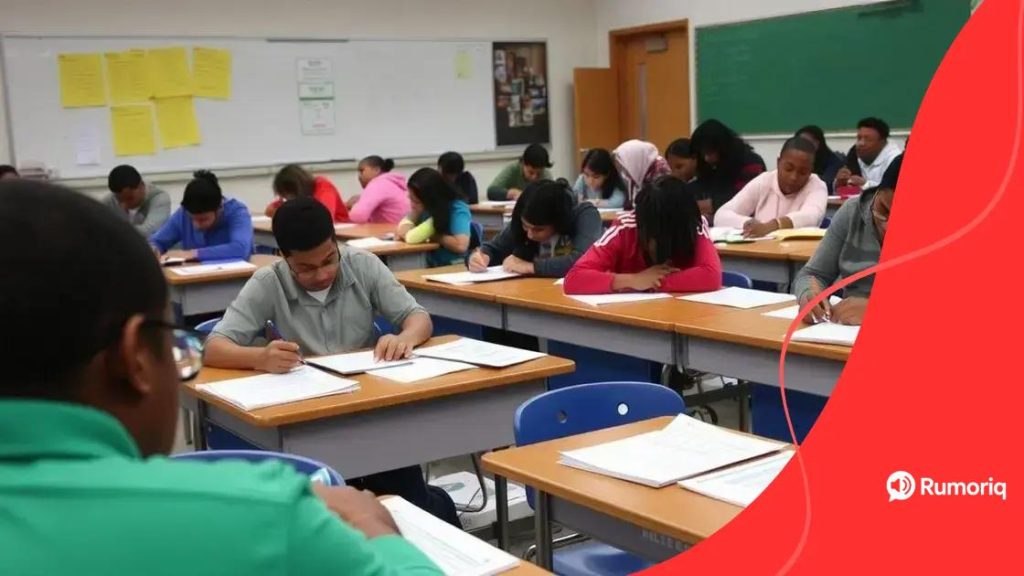Standardized testing changes US education landscape

Anúncios
Future trends in standardized testing in the US include increased technology integration, a shift to skills assessment, enhanced inclusivity for diverse learners, and ongoing educator feedback to improve testing practices.
Standardized testing changes US have sparked ongoing debates about their effectiveness in education. What do these shifts really mean for students and teachers? Let’s dive into the details.
Anúncios
An overview of standardized testing in the US
Standardized testing plays a crucial role in the US education system. It helps measure student performance across various subjects. This testing method is designed to provide a level playing field for all students.
History of Standardized Testing
The roots of standardized testing in the US trace back to the early 20th century. Initially, these tests aimed to assess cognitive abilities and academic achievement. Over the years, standardized tests evolved, becoming essential tools for evaluating educational effectiveness.
Types of Standardized Tests
In the US, there are several types of standardized tests:
Anúncios
- Achievement tests measure student knowledge on specific subjects.
- Aptitude tests assess potential learning capacity.
- National assessments evaluate performance on a larger scale.
- State assessments ensure that students meet educational standards.
Each type serves a specific purpose, helping educators and policymakers make informed decisions.
Additionally, standardized testing has sparked debates about fairness and effectiveness. Critics argue that these tests can create undue stress on students and may not accurately reflect their abilities. Others believe that they provide valuable insights into teaching practices and student needs.
The Role of Standardized Testing Today
Today, standardized testing remains vital in assessing educational outcomes. Schools and districts use test results to identify strengths and weaknesses in their curricula. This information can guide improvements and resource allocation. Furthermore, standardized tests are often used for college admissions, maintaining their significance beyond K-12 education.
As we continue to evaluate the effectiveness of standardized testing, questions about its future and impact persist. Balancing accountability with a more holistic approach to education will be essential. This involves considering alternative assessments that may better capture student learning. The conversation surrounding standardized testing is ongoing and critical for the future of education in the US.
Key changes in standardized testing policy
Over the years, key changes in standardized testing policy have significantly reshaped the educational landscape in the US. These changes aim to address concerns about fairness, accessibility, and educational outcomes.
Shift Toward Inclusivity
One notable change is the increasing push for inclusivity in testing. Policymakers recognize that standardized tests must accommodate students with various needs. This has led to the development of alternative testing formats and more supportive testing environments.
Emphasis on Critical Thinking
The focus of standardized testing is also shifting from rote memorization to critical thinking skills. Many states are now incorporating assessments that require students to analyze information and solve problems creatively. This approach prepares students better for real-world challenges.
- Tests now assess higher-order thinking skills.
- Performance tasks are included to measure application of knowledge.
- Emphasis on collaboration and communication skills.
These changes seek to create a more comprehensive evaluation of student learning, recognizing the limitations of traditional testing methods.
Furthermore, the frequency of standardized testing has been a topic of debate. Some districts have opted for fewer assessments, choosing to focus more on formative assessments that guide learning. The goal is to create a more balanced approach that reduces stress while still ensuring accountability.
Accountability and Transparency
Accountability remains a critical aspect of testing policy. There are ongoing efforts to ensure transparency in testing processes and outcomes. This focus helps parents and educators understand how well schools are performing.
As standardized testing policies evolve, monitoring their impact on educational equity is crucial. The challenge lies in balancing rigorous assessments with the need to provide a fair testing environment for all students.
Impact of standardized tests on student performance

The impact of standardized tests on student performance is a topic of great importance. These tests are designed to measure how well students are learning and to evaluate school effectiveness. However, their effects are complex and can vary widely among different groups of students.
Measurement of Academic Success
Standardized tests provide a standardized measure of student achievement in subjects like math and reading. Schools and teachers rely on these assessments to gauge how students are performing against set benchmarks. High scores can lead to recognition and funding for schools, while low scores may indicate areas needing improvement.
Emotional and Psychological Effects
While these tests can highlight academic success, they also place significant pressure on students. The stress of preparing for and taking standardized tests can affect performance negatively. Many students feel anxious, which can hinder their ability to focus and demonstrate their true capabilities during testing.
- Students may experience test anxiety, impacting their performance.
- High-stakes testing can create a fear of failure.
- The pressure to achieve can lead to burnout.
Additionally, some argue that the emphasis on testing can narrow the curriculum. Teachers may focus primarily on test preparation, leaving less time for engaging, creative learning experiences. This can restrict a student’s overall educational development.
It’s essential to consider the differences in how standardized tests impact various demographics. Factors such as socioeconomic status, English language proficiency, and learning disabilities can significantly affect test outcomes. In some cases, students may not have had the same access to resources, leading to disparities in performance.
Long-Term Consequences
The results of standardized tests can have long-lasting effects on students’ academic journeys. High scores may lead to advanced placement in more challenging courses, while low scores might limit students’ opportunities. As schools use these results for funding and policy decisions, the consequences of these tests extend beyond the classroom.
To fully understand the impact of standardized tests on student performance, ongoing evaluation and discussion are crucial. Balancing the use of tests with more holistic approaches to assessment can help ensure that all students have a fair opportunity to succeed.
Opinions from educators on testing effectiveness
Opinions from educators on testing effectiveness vary greatly across the nation. Many teachers believe that standardized tests provide a useful measure of student performance, while others argue they do not capture the full picture of learning.
Benefits of Standardized Testing
Supporters of standardized testing argue that these assessments help identify learning gaps. They provide valuable data that can inform instruction and highlight areas needing improvement. This quantitative data is important for schools striving to meet academic standards.
Concerns About Overreliance
Despite the benefits, many educators express concern over the overreliance on standardized tests. Testing can create a narrow focus on content that will appear on the exams, often at the expense of critical thinking and creativity. Teachers may feel pressured to teach to the test, which can limit their ability to engage students in deeper learning.
- Assessment may not reflect real-world skills.
- Stress and anxiety can affect students’ performance.
- Teaching strategies may become limited by testing schedules.
Many educators advocate for a balanced approach. They suggest incorporating multiple forms of assessment to gain a more comprehensive view of student learning. This can include project-based assessments or portfolios that allow students to showcase their skills in a more meaningful way.
Voices of Experience
Teachers’ experiences vary widely, adding depth to the discussion. Some have seen improvements in student motivation when test results lead to recognition or rewards. Others note that these tests can disproportionately impact students from underprivileged backgrounds, who may not have the same preparation or resources as their peers.
Moreover, as education continues to evolve, so too must our approach to assessment. Many educators are calling for reforms that prioritize student learning and understanding over mere performance metrics. The ongoing discussion about the role of standardized tests in education is critical for shaping a more equitable system.
Future trends in US standardized testing
Future trends in US standardized testing are likely to transform how education is assessed and implemented across the country. As technology advances and educational needs evolve, standardized tests will need to adapt.
Increased Use of Technology
One significant trend is the increased incorporation of technology in testing. Online assessments can provide immediate feedback, making the testing process faster and more efficient. They also have the potential to make testing more interactive and engaging for students.
Emphasis on Skills Over Memorization
There is a growing emphasis on assessing skills rather than just rote memorization. Future assessments may focus more on critical thinking, problem-solving, and the application of knowledge. This shift recognizes that real-world challenges require more than just factual recall.
- Performance-based assessments may become more common.
- Portfolios showcasing student work could be used alongside tests.
- Collaboration and communication skills may be evaluated through group projects.
These changes are expected to create a more comprehensive view of student learning and capabilities.
Greater Focus on Equity
Future trends will also likely involve a stronger focus on equity in testing. Educators and policymakers are increasingly aware of the disparities that affect student performance. Efforts will be made to ensure standardized tests are fair and accessible to all students, regardless of their background.
Innovations in testing may include adjustments to testing formats to better accommodate diverse learners, such as those with disabilities or English language learners. The goal is to create an inclusive testing environment that accurately reflects student potential.
Feedback and Continuous Improvement
As the landscape of education shifts, so too will the feedback mechanisms related to standardized testing. Continuous improvement based on data and research will be essential. This process will involve gathering input from educators, students, and parents to refine testing practices and ensure they serve the needs of all stakeholders.
Ultimately, the future of standardized testing in the US holds the promise of creating a more equitable and effective assessment system. By embracing technological advancements, prioritizing skills, and focusing on inclusivity, the educational landscape can better prepare students for success.
FAQ – Questions about the Future of Standardized Testing in the US
What are the upcoming trends in standardized testing?
Upcoming trends include increased technology use in assessments and a focus on skills over memorization.
How will inclusivity be improved in standardized testing?
Efforts will be made to ensure tests are fair and accessible for all students, including those with disabilities.
What type of skills will future standardized tests assess?
Future tests are expected to evaluate critical thinking, problem-solving, and real-world application rather than just knowledge recall.
Why is educator feedback important in testing reforms?
Educator feedback is crucial for refining testing practices, ensuring they meet the needs of students and improve learning outcomes.